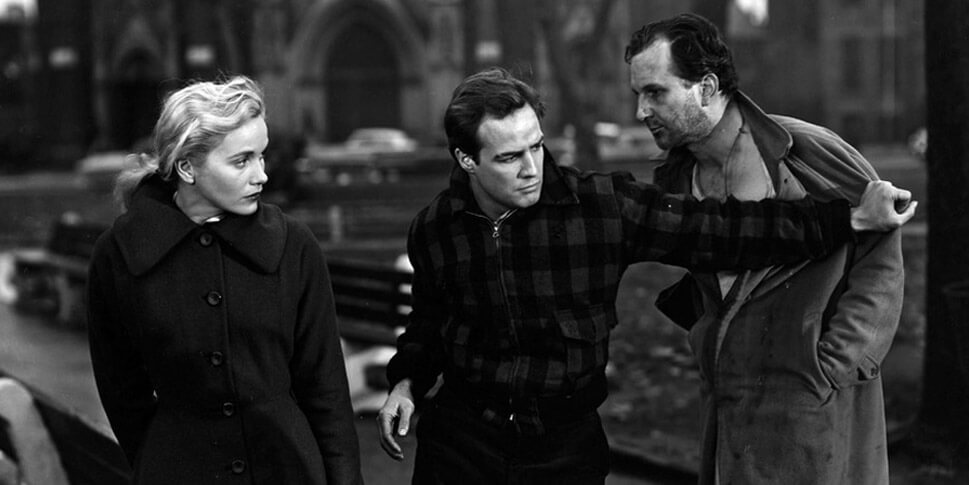Ed: This is one of a series of conference notes from the recent LAWCHA conference. If you have reflections from one of the panels or plenaries, please send them along.
Recap of #LAWCHA19 session: “The Dramatic Media’s Representations of Workers , Unions, and Labor Conflict in 1950s America”
We were treated to a fascinating panel on historical representations of labor in the media “past and present” in a panel organized by David Witwer. From the films The Pajama Game and On the Waterfront to historical v. screenplay versions of “mobster” history, the panelists presented provocative discussions of what people have taken away about “labor,” workers, unions, from these films.
Catherine Rios, a screenplay writer, is in the process of developing David Witwer’s award-winning Shadow of a Racketeer: Scandal in Organized Labor into a screenplay for television audiences. She presented a fascinating comparison between the screenplay and traditional history, arguing that screenplay writers have the luxury of working with the most dramatic of historical moments without getting bogged down in the historical detail. She argued that labor history, in particular, is full of drama and makes good fodder for television productions. What was missing was a just a little snippet of the difference. I was left imagining Witwer’s great history on the television screen and had hoped Rios would give us a sneak-peak!
Eric Kaufman presented great analyses of the 1938 International Ladies Garment Workers Union (ILGWU)-produced and performed play Pins and Needles and the 1957 hit comedy The Pajama Game starring Doris Day. As Rios had, Kaufman interrogated the productions for their ability to resonate with audiences. What made the labor aspects of the stories resonate with audiences in those decades? Kaufman focused most on the infamous Bob Fosse’s choreography of a strike scene in The Pajama Game. Here, he argued, you find Fosse choreographing workers engaged in silly dance movements to a kind of industrially-driven machine-like cadence. The plot emphasized labor-management cooperation. What was the message, post Taft-Hartley? Kaufman argued that union members were infantilized and encouraged to just get along with the boss. Representations had definitely changed from the pro-union message presented in the 1938 Broadway production of Pins and Needles (which was also performed for the Roosevelts at the White House).
We did not get much of a chance to talk about the fact that the factory workers were all women engaged in making pajamas. A more thorough gendered analysis would, I think, add an important caveat to Kaufman’s analysis. You would think 1957 audience would have more easily infantilized an all-female workforce producing pajamas (a stand-in for union members writ large in the 1950s?). Kaufman argued briefly about the androgynous costumery, something I admit I didn’t think about. Here are two links, the second replete with ads, should any of you want to see more of what Kaufman was analyzing: Bob Fosse’s “Steam Heat” and the whole production
Finally, Kathleen Newman, an expert on 1950s popular culture, presented what was, for this commenter at least, a contentious argument (all good ones are) about The Garment Jungle and On the Waterfront. Newman argued that the films enable us to use the labor theory of culture to identify how pro-labor or anti-labor Americans were when the films debuted . I had always interpreted On the Waterfront as an anti-union film. The film’s main character, Marlon Brando, confronts an entirely corrupt longshoremen’s union, is an accomplice to a murder-cover up, then testifies the “truth” in order the clear his conscience and expose union corruption. He’s then blacklisted by the same corrupt union’s hiring hall and never works on the docks again.
Had I had NO experience with unions, I’d have run from them after seeing the film. The film’s message to me was always: unions are corrupt and will protect their own at any cost. To my surprise, then, Newman argued that On the Waterfront was actually a pro-labor film. She finds evidence for such in earlier versions of the screenplays and in the New York Times’ Pulitzer Prize winning article series Crime on the Waterfront from which On the Waterfront was drawn. Robert Siodmak, Budd Schulberg, and Arthur Miller had written versions that were much more pro-labor. Schulberg’s script payed homage to “The American Longshoremen: Whose Muscles move into our homes and steel to our fighting fronts” and Arthur Miller’s The Hook which was extremely critical of the “shape-up” process by which dockworkers were hired each day (and, presumably, why the union hiring hall was a better system). Anti-communist (safe to say) director Elias Kazan worked tirelessly to get a version of dockworkers’ stories onto the big screen. It was he who made Communists the enemy. As such and because there was so much knowledge at the time of dockworkers’ struggles, Newman argues that audiences would have seen the film as pro-LABOR (perhaps not pro-union). Given the union density (50% plus) of the era and the attention given to dockworkers in the press, perhaps Newman is right. Being pro-labor is quite different thing than being pro-union. The film, then, I’d argue, if Newman is right, separates the two for its audiences.
This was a great session, one I was happy to be a part of. There was simply not enough time for the extended discussion these treatments deserved. We are all engaged in making labor’s current struggles, as well as its history, better known to varying audiences. Rios argued that we can and should continue to attempt to change the larger narrative. All of the panelists encouraged us to think about our audience, what does and doesn’t (did and didn’t) resonate with them and why; it’s a constant endeavor for those of us interested in telling labor’s history.

Lisa Philips is the author of A Renegade Union: Interracial Organizing and Labor Radicalism. She is working on history of labor relations at Disney and teaches at Indiana State University.






